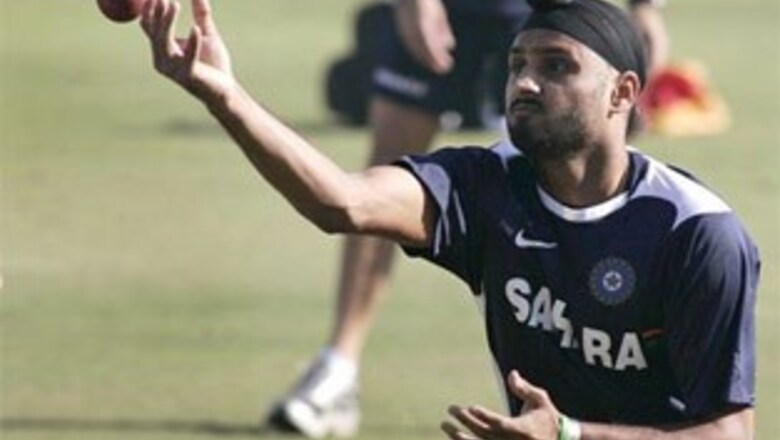
views
Brisbane (Australia): Harbhajan Singh started 2008 by escaping a ban in an acrimonious racism row in Australia and finished it as one of the leading wicket-takers, helping India to back-to-back Test series wins over the Australians and English.
The feisty offspinner's Teflon-like ride mirrored India's season inside and outside the arena as cricket's commercial powerbroker flexed its considerable clout.
Just as the lucrative Indian Premier League and the numerous Twenty20 competitions that sprouted around it threatened to elevate the shortest form of the game to the highest standing in cricket, some tight Tests involving India, England, South Africa and Australia revived the five-day game.
Interest heightened when India's late successes over Australia and England, cricket's oldest powers, were sandwiched around terror attacks in Mumbai that killed 164 people and threatened to derail the game on the subcontinent.
The November attacks, in which a luxury hotel that frequently hosts international cricket teams was among the prime targets, sent the English squad packing for a week, caused the cancellation of the inaugural Champions League that was supposed to feature eight provincial teams from five countries and, inevitably, caused India's refusal to tour Pakistan next month.
The Indian government blamed Pakistan-based militants for the attacks.
So while India was able to lure England back this month for the Test series — after the English abandoned a limited-overs series they were losing 5-0 — with security assurances, it was not willing to reciprocate for neighboring Pakistan.
England was widely commended for returning to India, although former Pakistan captain Rashid Latif was outspoken in his criticism of both international and national administrators for what he thought were the double standards of encouraging tours to India while turning their backs on Pakistan due to safety fears.
But International Cricket Council president David Morgan said England's return, and it's subsequent six-wicket loss in the first Test in Chennai, continued "the feel-good factor around the longest form of the game".
Cricket "has probably never been stronger than it is right now with three viable and vibrant forms at international level, including the positive effect of Twenty20," Morgan said. "The Perth Test between Australia and South Africa has also produced some great cricket and (recent matches) have been a real reminder that Test cricket is the pinnacle of our sport with its unique ability to produce twists and turns and sustained drama."
Latif said India's status as the game's key market gave it the pulling power Pakistan lacked. The eight-nation Champions Trophy in Pakistan was postponed in September after five teams refused to tour.
"It's all about money and nothing else," Latif said. "If India didn't have the financial clout no team would bother to go there so soon after the Mumbai attacks."
Latif wasn't the only critic of India's cashed-up backers.
Sections of the media openly questioned who was running the sport when Harbhajan was let off a two-match ban on appeal in January after allegedly making a racist taunt against allrounder Andrew Symonds, the only black player on the Australian team.
That decision came amid Indian threats to boycott the remainder of the tour. The ICC also acquiesced to India's demands for veteran West Indies umpire Steve Bucknor to be removed from the series after making some incorrect decisions.
Harbhajan pleaded guilty to a lesser charge and was fined 50 percent of his match fee — he later served a five-match ODI ban for slapping a teammate in a domestic Twenty20 match.
Australia had won the disputed Sydney match to equal its world record of 16 consecutive Test wins and take a 2-0 lead in the four-match series, but lost the subsequent match in Perth and only narrowly held on to the series.
Symonds went to India in April as one of the highest-paid players in the inaugural IPL Twenty20 but was later dropped from the Australian lineup for going fishing instead of attending a team meeting in Darwin ahead of a limited-overs series against Bangladesh.
He said he felt let down by Cricket Australia's handling of the racism row and he missed the four-Test October tour to India which the home team won 2-0.
Harbhajan, who took 15 wickets in the series, ended with 63 Test wickets for the year, one behind South Africa paceman Dale Steyn as the most prolific wicket-taker to Christmas.
Over the course of India's last two series wins, Sachin Tendulkar became the leading runscorer of all time and Anil Kumble retired at No. 3 on the all-time Test wicket-takers list.
"We are working well as a unit... and we all enjoy the success of each other," said paceman Zaheer Khan, voted player of the series in the 1-0 win over England this week. "It's been a great year for Indian cricket."
Australia's position at No. 1 came under the most pressure in a decade with South Africa and India closing in.
The search for able replacements for legspinner Shane Warne and paceman Glenn McGrath — two of the leading wicket-takers of all time — has been slower than Australian selectors had hoped.
As it neared the end of a tumultuous year, a stuttering Australia bowling attack was unable to prevent resurgent South Africa chasing 414 to win last week's series-opening Test in Perth — the second-highest successful fourth-innings run chase in Test history.
It was South Africa's first Test victory in 14 years on Australian soil and put the hosts under enormous pressure in the series, having never won a three-Test series after losing the first match.
South Africa even had the chance to move to No. 1 in the rankings with a 3-0 series win in Australia, but it would need more history to achieve it. The Proteas have never won a series in Australia.















Comments
0 comment